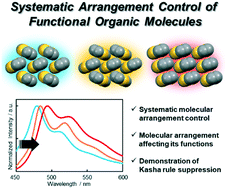Systematic arrangement control of functional organic molecules†
Abstract
Functional organic molecules, especially π-conjugated molecules, have tunable functions according to their molecular design. Since their properties are significantly affected by the overlap of π-orbitals between adjacent molecules as well as the spread of π-conjugation within a molecule, their molecular arrangements as well as their molecular structures have been recognized as critical. The current work reports the systematic arrangement control of functional organic molecules without affecting both their molecular and layered structure. Disulfonic acid was designed with 2,2′-bithiophene (BT) as a common functional organic molecular module along with a twisted phenylene group, sandwiched between BT and the sulfo group. The introduction of the phenylene group enabled the functional organic molecular module to avoid the electron-withdrawing effect and steric hindrance caused by the sulfo group. Organic salts were formed from the disulfonic acid and butylamine isomers. Depending on the amount of steric hindrance introduced by these butylamine isomers, the molecular arrangement of BT systematically and precisely transitioned from an edge-to-face herringbone structure to a novel face-to-face slipped stack structure. This systematic control established the true relationship between the molecular arrangement and the luminescence properties even in the identical molecular structures, which also led to demonstrating the suppression of the Kasha rule in identical functional molecules. In addition, the organic salt with a face-to-face slipped stack structure exhibited an extremely long-lived luminescence component with 6.87 ns (lifetime) based on the strong π/π interaction.



 Please wait while we load your content...
Please wait while we load your content...